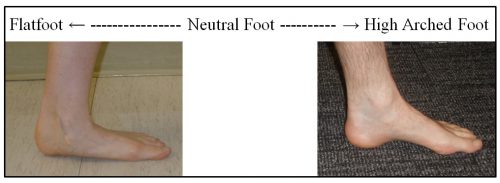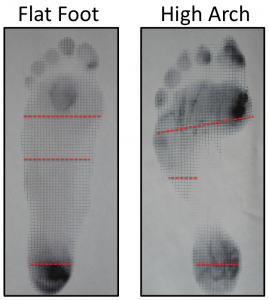Foot Types
Characteristics of a Flat Foot
Characteristics of a High Arch Foot
Watch Video: Foot Types
While the bones, tendons, and joints have only small variations, the way these structures interact with one another can result in a variety of different foot types. These foot types follow a basic spectrum that ranges from a flatfoot on one end, to a high arched foot on the other (Figure 1).
Figure 1: The spectrum of foot shapes

All foot types within this spectrum are considered normal. However, people with certain foot types are prone to develop certain corresponding symptoms or conditions. For example, people with flatfeet tend to develop posterior tibial tendonitis (irritation of the tendon on the inside of the ankle), and people with high arched feet tend to develop peroneal tendonitis (irritation of the tendons on the outside of the ankle). The reason is that a person’s foot type dictates how the forces are transmitted through the foot. Most chronic foot conditions (ex. Tendonitis) are related to the way the foot absorbs force repetitively with each step. Therefore by determining a person’s foot type, a doctor can quickly and easily get an idea of possible conditions that might be the cause of a patient’s discomfort (see Table 1).
Table 1: Conditions associated with common foot types
| FLATFEET predispose to the following conditions: | HIGH ARCHED FEET predispose to the following conditions: |
| Acquired Adult Flatfoot deformity (Posterior Tibial Tendonitis) | Peroneal Tendonitis |
| Plantar Fasciitis | Ankle Instability |
| Tarsal Tunnel Syndrome | Ankle Sprains |
| 2nd metatarsal stress fractures Hallux Valgus (Bunions) | Jones fractures (5th Metatarsal stress fractures) |
| Sesamoiditis Plantar Fasciitis |
How to tell what your foot type is
In general, the easiest way to determine your basic foot type is to note the kind of imprint your foot makes when you step onto a soft surface. If the entire foot or the majority of the foot is showing, this indicates a flat foot (Figure 2). On the other hand, if only the heel and ball of the foot are showing, with very little imprint in the middle portion of the foot, this indicates a high arch foot (Figure 2). In the doctor’s office, a tool known as a Harris Mat can be used to determine loading pattern and therefore foot type.
Figure 2: Imprints from a flatfoot and a high arched foot

Simple foot-type test at home: If you would like to get an idea of your foot type while still at home, you can imitate a Harris Mat using a bit of water and a paper towel. Simply wet your foot with a small amount of water (don’t soak your foot too much) and briefly step onto the paper towel. The imprint left by the water should provide a nice picture of where weight is distributed on your foot
Edited by Stephen Pinney MD, October 25th 2025. Previously edited by David Oji, MD